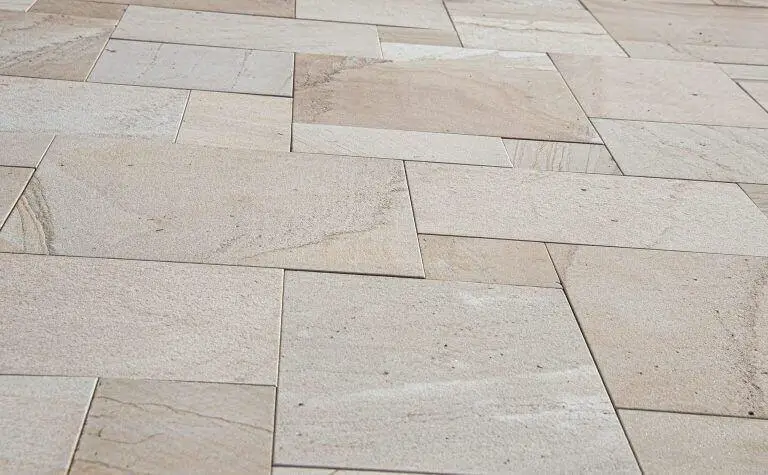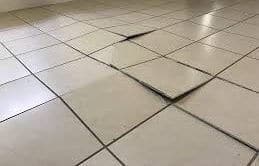Tile flooring is a beautiful addition to places like the kitchen, bathroom, and toilet. They are waterproof, durable, and are easy to maintain. Even though they are durable, when placed in a high-traffic area, they’ll likely wear out, crack, or loosen.
If you spot any issue on your tile floor, you need to address it quickly before it causes further issues like water seeping under the cracked tile and becoming infested with mold. Find out the simple tips we using in fixing lose floor tiles.
Related: How to repair cracked floor tiles
How To Fix Loose Floor Tiles
Table of Contents
Without Having To Remove The Tile
You can fix loose tiles without having to remove the tile, and it is a very easy process;
First, drill a hole into the grout beside the loose tile; you need the hole to be deep enough to allow the adhesive that will be added get into underneath the loose tile.
Place the spout of epoxy or adhesive you are using into the hole and squeeze some into the hole.
Then place a heavy object on top of the tile to hold it down against the adhesive and remove air bubbles.
If you have adhesive seeping out of the sides of the tile, use a damp cloth to wipe it off.
Allow the heavy object to remain on the tile for at least 24 hours, and then remove it and apply new grout over the hole that you drilled.
Allow the grout to dry, and your floor should be good as new.
Removing The Tile
If you have cracked tiles, you will need to remove it entirely and replace it with a new one.
Not only does it not look pretty, but it will also likely cause greater problems in the future because if you miss even a small gap while repairing the crack in a tile, this can allow water and air to seep beneath the tile and cause mold or for the tile to just crack again soon. So Do yourself a favor and replace, rather than repair, a broken tile.
When trying to replace a broken tile, you have to be very careful to avoid damaging the surrounding tiles, so instead of trying to pull out the tile in one or two big chunks, you may have to break down the tiles into smaller pieces to enable you to remove it easily.
To do this, you need to first cut through the grout of the broken tile, then try to see if you can lift it up; if not, you can use a drill or hammer to breakdown the tile into smaller pieces.
When doing this, you have to be very careful to avoid damaging a nearby tile. Then vacuum up any dust and debris so that you can replace the tile.
This procedure is very easy, and you can save yourself the few bucks you would pay a contractor to fix it for you. When replacing your tile, you want to make sure you get a tile very similar to the removed one.
If you couldn’t find it, you may have to replace all of the tiles to make sure it matches everything else except you don’t mind mix-matched tiles.
So after removing the old tile and getting a new replacement, apply some adhesive to the new tile and floor and set the tile in place, then press it down evenly until it’s level with the surrounding tiles.
Once the adhesive has dried completely, you can go ahead and grout the area.
Causes Of Loose Tiles
There are a couple of reasons why your tile floor can become loose, and they include;
Type Of Adhesive Used
To hold a tile against the floor, you will need to apply some adhesive, and you want to make sure that the adhesive you use is strong enough to still stay intact and hold down the tiles even after years of use.
Although it is inevitable for the adhesive to become loose over time, using a high-quality one will help to increase the time the tile will be held in place.
Also, when applying the adhesive to your tile, you want to make sure you do not apply the adhesive too thick, too thin, and it is evenly spread out underneath the tile.
Using a method like spot bonding where a dot of adhesive is placed on each end and center of the tile will allow too much space underneath the tiles, which will lead to premature cracking and loosening. So both the type of adhesive and method of application matters here.
Placing The Tile In The Wrong Area
When installing your tiles, you do not want to place them over joints in the floor or wall. Placing a tile over a joint can make the tile to be unstable, and when the house shifts or settles, the joint is going to shift more than anywhere else in the house. This can cause the tile to break.
Moisture
Tile grout is usually made of cement, which is very porous, so when spills occur or when the tile is placed in a moisture-prone place, the tile and grout begin to absorb water, and this can get to the adhesive and cause it to lose its effectiveness, thus creating a loose tile.
So you want to make sure sure the tiles grout in areas like the bathroom are properly sealed and wipe off spills immediately they occur to prevent moisture from getting into the tiles.
House settling
As your house begins to settle over time, the foundation and walls can shift a little. Although when tiles are installed, contractors usually allow a small perimeter so that the tiles have room to shift and move when the house begins to settle.
If no space is left or if the house settles beyond the amount of space left, the tiles can become loose or cracked.
Weather
If the tiles were installed outdoors, the weather is going to have a great impact on the lifespan of your tiles. This is because precipitation can get into the tiles adhesive and damage it.
When the tiles are exposed to extreme temperatures like hot or cold weather, it can cause the tile to either shrink or expand, and over time these minor changes can cause cracks and loosen the adhesive, thus creating loose tiles.
Heavy load
If a refrigerator, washer, dryer, or freezer is placed on a tile floor, the weight of the item can cause the tile to become cracked or loose. Although tiles are manufactured to comply with the standards for tile strength.
This means that each individual tile needs to be able to withstand 250 pounds of pressure. However, this test is done with dead weight, so if someone is to drop the appliance on the tile, the impact of that same weight will cause the tile to crack.
Differences In Surfaces
A significant difference between the surface beneath the tile and the underside of the tile and can lead to faster loosening and cracking of tiles.
Conclusion
The process of how to fix loose floor tiles is very easy to carry out, and you don’t require special tools, but you still want to be careful when handling items like a drill.


